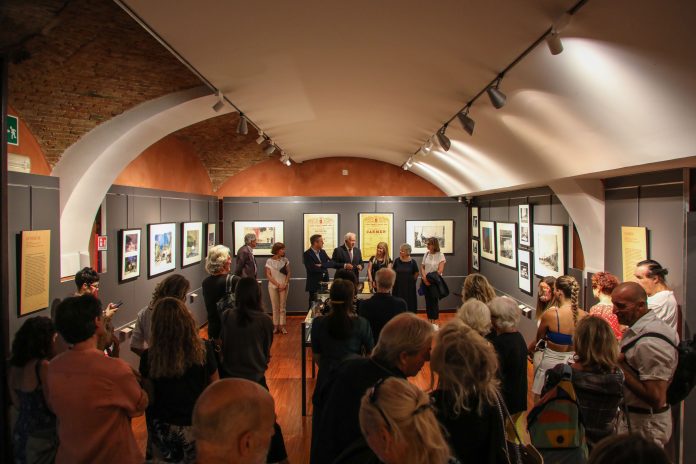by InTrieste
In a grand ceremony on Tuesday afternoon, the Palazzo Gopcevich hosted the opening of “Zigaina on Stage,” a compelling new exhibition marking the centenary of Giuseppe Zigaina’s birth. The event was held in the Sala Attilio Selva and organized by the Civic Theater Museum “Carlo Schmidl.”
The exhibition is a significant tribute to Zigaina, who was born in Cervignano del Friuli on April 2, 1924, and passed away in Palmanova on April 16, 2015. Despite his notable contributions to the world of theater, Zigaina remained relatively underrecognized until recent years. His centennial is now being celebrated with an extensive showcase of his work.
This exhibition is part of the broader “Zigaina 100 / Anatomy of an Image” project, a collaboration involving the Municipality of Cervignano del Friuli, the Autonomous Region of Friuli Venezia Giulia, and the Regional Cultural Heritage Authority (Erpac Fvg). Curated by Stefano Bianchi and Cristina Zacchigna, the display features a wealth of materials including contributions from Franco Però and Susanna Gregorat, and administrative coordination by Francesco Recanati, with graphic design by BASIQ.
The exhibition focuses on three major works by Zigaina designed for the Teatro Verdi in Trieste: “Il convitato di pietra” (1969), “Carmen” (1970), and “Goyescas” (1982). These works represent a significant period of Zigaina’s career, reflecting his innovative approach to stage design. Complementing these are three paintings from the Revoltella Museum, offering a tribute to Zigaina’s artistic legacy through his preserved works.
Zigaina’s first major theatrical engagement was with the set design for Albert Camus’s “I giusti” at the Teatro Auditorium in 1967. Although only stage photos remain of this production, Zigaina’s approach to creating a singular, enclosed space for the drama highlighted his ability to convey the psychological intensity of the play.
His subsequent work on “Il convitato di pietra” marked his first major opera project, where he employed a series of detailed sketches to bring a new interpretation to the classic Don Giovanni myth. Zigaina’s work on Georges Bizet’s “Carmen” further solidified his reputation, transforming conventional set designs with his distinctive style and bold color contrasts.
Zigaina’s final major theatrical contribution, “Goyescas,” premiered in 1982 and is noted for its seamless integration of painting and set design. The opera, composed by Enrique Granados, saw Zigaina’s vision manifest in a stage setting that beautifully merged with the narrative of love, jealousy, and death.
The exhibition also intersects with Zigaina’s paintings housed at the Revoltella Museum, including works such as “Braccianti sul carro” (1953), “Il fucilato” (1966), and “Dal colle di Redipuglia: un radioso mattino” (1973). These paintings reflect Zigaina’s stylistic evolution and thematic concerns, providing a fuller understanding of his artistic range.






























